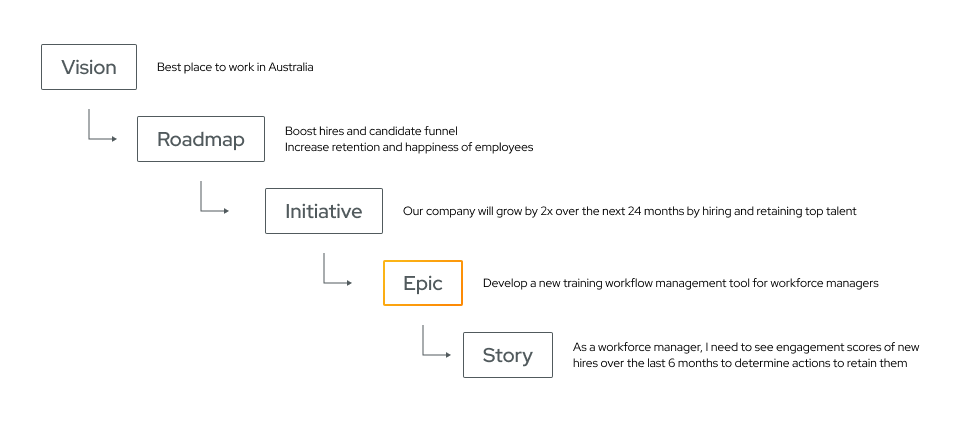Introduction
If you use or are interested in an agile approach to delivery, “epic” is a term you want to understand. Epics are a way of organising large items of work and are applicable to all industries, sectors and agile teams.
In this post, we’ll define epics in agile, show some examples of how they’re used in business today, and provide tips and reminders as you apply epics in your own team or company.
What is an epic?
An epic represents a large body of work to be completed. This definition may seem simple, but can be interpreted in different ways. Let’s take a look at the history of epics and how they’re used by agile teams today.
The term “epic” was coined by Mike Cohn in 2004 in his book, User Stories Applied: For Agile Software Development. In his original definition, Cohn says that epics are just large user stories. Over time, the definition of an epic shifted from an adjective to describe user stories to a noun or entity of work.
Today, the exact definition of an epic may vary based on your organisation’s ecosystem of work, however, the bottom line for all epics is that if used well, they provide value, can be tested, measured, and ultimately provide value for your business.
This materialises as an item or tool in an organisation’s hierarchy structure for visualising and delivering upon its goals. Typically, from the top down, a hierarchy structure would include the vision, roadmap, theme, initiatives/OKRs, epics and finally user stories, each step informing and influencing the next.

Why are epics important?
Executives
Understanding epics and the way that they’re used in the context of your business is imperative, no matter what role you have on the team. They bridge the gap between company wide initiatives, business goals and the technical work teams do on a daily basis. Epics are a pivotal stepping stone from big ideas to tactical action plans, and everyone in the organisation benefits from having a clear understanding of what they are and how to utilise them to achieve the best outcomes and value.
For executives and leadership, knowing how your teams create and use epics ensures that you have clear visibility that the day to day operations align with the initiatives that support your roadmap and vision of the company. Having all the data available to support communication between leadership and teams allows for leadership to make the right decisions for the company without assumptions or misperceptions.
Delivery teams
For other leaders and facilitators such as scrum masters, project managers or architects, epics are a great way to organise work, track progress on goals and ensure the work that your teams are doing aligns to a larger initiative. They also provide focus and can highlight dependencies between work items or teams, enabling you to take action and prevent blockers or unwanted surprises.
For team members such as subject matter experts, engineers or other contributors, it’s valuable to use epics to feel connected to the bigger picture. Every user story you develop, piece of content you create or event you plan isn’t a standalone item, rather, an instrumental piece in your company’s overall success.
Tips for better agile epics
Ensure your epic is the right size. An epic, as Mike Cohn originally said, is bigger than a user story, however, should be small enough to be complete in a reasonable timeframe. Typically this means within 1-4 sprints, but can sometimes last longer due to the complexity or scope to create the value intended from the epic.
A common pitfall is to use epics as a never-ending bucket for work. For example, an epic might be titled, “Technical Debt”, and turn into a never-ending list of tasks to complete in planned or prioritised order. There are exceptions to having evergreen epics, but in general, an epic should deliver value and be measured to its completion. If not, it can be difficult to analyse metrics or results and be easy to lose sight of why the work items in the epic are important to the business.
When creating epics, remember to keep a customer-centric approach using design thinking. The value for the end user should always be a top priority. Also, consider the culture of your organisation to ensure it fits the norms and aligns with the reporting and metrics leadership needs to keep track of.
Closing
While understanding the meaning of agile epics may seem confusing, don’t be discouraged! Epics, like all tools, should improve your process and simplify your workflow to make you and your team more efficient, productive and satisfied. Now that you know a bit of the history, common uses and examples of epics, you can help your team thrive and focus on delivering value to your customers.